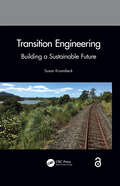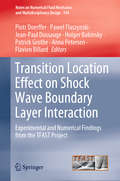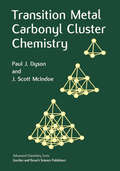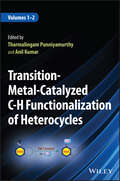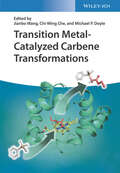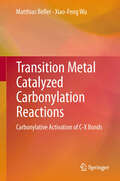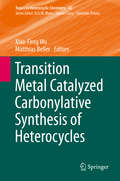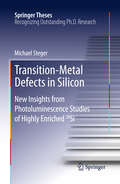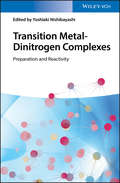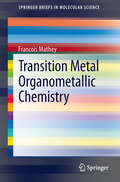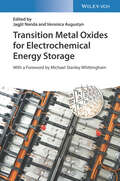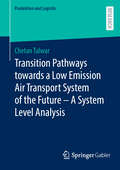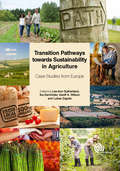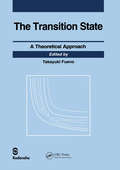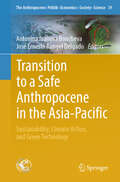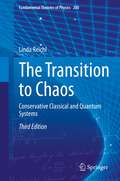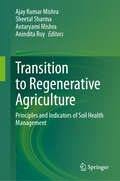- Table View
- List View
Transient Receptor Potential Channels
by Md. Shahidul IslamTransient Receptor Potential Channels offers a unique blend of thoughtfully selected topics ranging from the structural biology of this fascinating group of ion channels to their emerging roles in human diseases. This single book covers TRP channels of yeasts, flies, fishes frogs and humans. And from the biophysics of primary thermo-sensory events in cells to the thermosensation at whole organism level, from physiology of pain to the development of pain-killers, from psychiatric illnesses to cancers, from skin cells to sperms, from taste buds to testes, from established facts to heated debates, this book contains something for every TRP enthusiasts, beginner and expert alike. It includes crucial background information, critical analysis of cutting edge research, and ideas and thoughts for numerous testable hypotheses. It also shows directions for future research in this highly dynamic field. It is a book readers will be just as eager to give to others as keep for themselves.
Transition Engineering: Building a Sustainable Future
by Susan KrumdieckEngineering Transition: Building a Sustainable Future examines new strategies emerging in response to the mega-issues of global climate change, decline in world oil supply, scarcity of key industrial minerals, and local environmental constraints. These issues pose challenges for organizations, businesses, and communities, and engineers will need to begin developing ideas and projects to implement the transition of engineered systems. This work presents a methodology for shifting away from unsustainable activities. Teaching the Transition Engineering approach and methodology is the focus of the text, and the concept is presented in a way that engineers can begin applying it in their work.
Transition Location Effect on Shock Wave Boundary Layer Interaction: Experimental and Numerical Findings from the TFAST Project (Notes on Numerical Fluid Mechanics and Multidisciplinary Design #144)
by Piotr Doerffer Pawel Flaszynski Jean-Paul Dussauge Holger Babinsky Patrick Grothe Anna Petersen Flavien BillardThis book presents experimental and numerical findings on reducing shock-induced separation by applying transition upstream the shock wave. The purpose is to find out how close to the shock wave the transition should be located in order to obtain favorable turbulent boundary layer interaction. The book shares findings obtained using advanced flow measurement methods and concerning e.g. the transition location, boundary layer characteristics, and the detection of shock wave configurations. It includes a number of experimental case studies and CFD simulations that offer valuable insights into the flow structure. It covers RANS/URANS methods for the experimental test section design, as well as more advanced techniques, such as LES, hybrid methods and DNS for studying the transition and shock wave interaction in detail. The experimental and numerical investigations presented here were conducted by sixteen different partners in the context of the TFAST Project. The general focus is on determining if and how it is possible to improve flow performance in comparison to laminar interaction. The book mainly addresses academics and professionals whose work involves the aerodynamics of internal and external flows, as well as experimentalists working with compressible flows. It will also be of benefit for CFD developers and users, and for students of aviation and propulsion systems alike.
Transition Metal Carbonyl Cluster Chemistry
by Paul J. Dyson J. Scott McIndoeTransition metal carbonyl clusters (TMCCs) continue to inspire great interest in chemical research, as much for their fascinating structures as for potential industrial applications conferred by their unique properties. This highly accessible book introduces the bonding, structure, spectroscopic properties, and characterization of clusters, and then explores their synthesis, reactivity, reaction mechanisms and use in organic synthesis and catalysis.Transition Metal Carbonyl Cluster Chemistry describes models and rules that correlate cluster structure with electron count, which are then applied in worked examples. Subsequent chapters explain how bonding relates to molecular structure, demonstrate the use of spectroscopic techniques such as NMR, IR and MS in cluster chemistry, and outline the factors contributing to the stability, dynamics and reactivity of clusters. The second part of this book discusses the synthesis and applications of TMCCs. It emphasizes the differences between the reactivities of clusters vs. mononuclear metal complexes, contingent to the availability of multiple-bonding sites and heterosite reactivity. The final chapters discuss reactions in which clusters act as homogeneous catalysts; including discussion on the use of solid and biphasic liquid-liquid supported clusters in heterogeneous catalysts. A useful reference for those commencing further research or post-graduate study on metal carbonyl clusters and advanced organometallic chemistry, this book is also a cornerstone addition to academic and libraries as well as private collections.
Transition-Metal-Catalyzed C-H Functionalization of Heterocycles, 2 Volumes
by Tharmalingam Punniyamurthy Anil KumarTransition-Metal-Catalyzed C-H Functionalization of Heterocycles A comprehensive guide to recent advances in this field Constituting the majority of all known compounds, heterocycles are structures that incorporate one or more heteroatoms within their core, thus exhibiting properties that are quite different from their all-carbon analogs. They are fundamental to all fields of chemistry and, therefore, their synthesis and modification has attracted a great deal of attention in the recent years. In this vein, transition-metal-catalyzed C-H bond functionalization forms a crucial tool for generating and analyzing heterocyclic compounds. Transition-Metal-Catalyzed C-H Functionalization of Heterocycles, Two-Volume Set, showcases diverse C-H functionalization methodologies and their incorporation into the latest research. The chapters serve as an essential tool depicting detailed site-selective functionalization of heterocyclic cores, along with a comprehensive discussion on their mechanistic approaches. Readers of Transition-Metal-Catalyzed C-H Functionalization of Heterocycles, Two-Volume-Set will also find: A detailed introduction to C-H activation along with the mechanistic aspects of transition-metal-catalyzed C-H bond activation reactions Easy-to-use structures with each chapter dedicated to a type of heterocycle and its specific functionalization methodologies A leading team of international authors in C-H bond functionalization Transition-Metal-Catalyzed C-H Functionalization of Heterocycles, Two-Volume-Set is a valuable guide for students and researchers in organic synthesis and process development, in both academic and industrial contexts.
Transition Metal-Catalyzed Carbene Transformations
by Jianbo WangPresents an up-to-date overview of the rapidly growing field of carbene transformations Carbene transformations have had an enormous impact on catalysis and organometallic chemistry. With the growth of transition metal-catalyzed carbene transformations in recent decades, carbene transformations are today an important compound class in organic synthesis as well as in the pharmaceutical and agrochemical industries. Edited by leading experts in the field, Transition Metal-Catalyzed Carbene Transformations is a thorough summary of the most recent advances in the rapidly expanding research area. This authoritative volume covers different reaction types such as ring forming reactions and rearrangement reactions, details their conditions and properties, and provides readers with accurate information on a wide range of carbene reactions. Twelve in-depth chapters address topics including carbene C-H bond insertion in alkane functionalization, the application of engineered enzymes in asymmetric carbene transfer, progress in transition-metal-catalyzed cross-coupling using carbene precursors, and more. Throughout the text, the authors highlight novel catalytic systems, transformations, and applications of transition-metal-catalyzed carbene transfer. Highlights the dynamic nature of the field of transition-metal-catalyzed carbene transformations Summarizes the catalytic radical approach for selective carbene cyclopropanation, high enantioselectivity in X-H insertions, and bio-inspired carbene transformations Introduces chiral N,N'-dioxide and chiral guanidine-based catalysts and different transformations with gold catalysis Discusses approaches in cycloaddition reactions with metal carbenes and polymerization with carbene transformations Outlines multicomponent reactions through gem-difunctionalization and transition-metal-catalyzed cross-coupling using carbene precursors Transition Metal-Catalyzed Carbene Transformations is essential reading for all chemists involved in organometallics, including organic and inorganic chemists, catalytic chemists, and chemists working in industry.
Transition Metal Catalyzed Carbonylation Reactions: Carbonylative Activation of C-X Bonds
by Matthias Beller Xiao-Feng WuTransition Metal Catalyzed Carbonylation Reactions is a comprehensive monograph focusing on carbon monoxide usage. This book provides students and researchers in organic synthesis with a detailed discussion of carbonylation from the basics through to applications. The authors have structured the book around the types of reactions, based on the different nucleophiles involved. Scientists working in carbonylation or with carbon monoxide, as well as teachers of organic synthesis can use this book to become familiar with this important area of organic chemistry.
Transition Metal Catalyzed Carbonylative Synthesis of Heterocycles
by Xiao-Feng Wu Matthias BellerThe series Topics in Heterocyclic Chemistry presents critical reviews on present and future trends in the research of heterocyclic compounds. Overall the scope is to cover topics dealing with all areas within heterocyclic chemistry, both experimental and theoretical, of interest to the general heterocyclic chemistry community. The series consists of topic related volumes edited by renowned editors with contributions of experts in the field. All chapters from Topics in Heterocyclic Chemistry are published Online First with an individual DOI. In references, Topics in Heterocyclic Chemistry is abbreviated as Top Heterocycl Chem and cited as a journal.
Transition Metal-Catalyzed Couplings in Process Chemistry
by Joshua R. Dunetz Javier MaganoThis one-stop reference source is the first on this new and exciting technology to focus on case studies of large-scale industrial applications, presenting the information and facts that are otherwise hard to find in the current literature.Authors from Pfizer, Merck, DSM, Novartis, Amgen, and Astra Zeneca, among others, use case studies to showcase project evolution from inception to early and late development, including commercial routes where applicable. Each case study details at least one transition metal-catalyzed cross-coupling step, with special emphasis on lessons learned from their implementation. The important issue of metal removal from the reaction mixtures to meet specifications and the different technologies available to accomplish this goal are also addressed. Finally, a small section covers novel technologies for cross-coupling with high future potential for applications on a large scale, such as metal removal on large scale, microwave and flow chemistry, as well as green chemistry.Of great interest to chemists working in the pharmaceutical, agrochemical and fine chemical industries, but also for every synthetic chemist working in academia.
Transition Metal Catalyzed Enantioselective Allylic Substitution in Organic Synthesis
by Uli KazmaierGiovanni Poli, Guillaume Prestat, Frédéric Liron, Claire Kammerer-Pentier: Selectivity in Palladium Catalyzed Allylic Substitution.- Jonatan Kleimark and Per-Ola Norrby: Computational Insights into Palladium-mediated Allylic Substitution Reactions.- Ludovic Milhau, Patrick J. Guiry: Palladium-catalyzed enantioselective allylic substitution.- Wen-Bo Liu, Ji-Bao Xia, Shu-Li You: Iridium-Catalyzed Asymmetric Allylic Substitutions.- Christina Moberg: Molybdenum- and Tungsten-Catalyzed Enantioselective Allylic Substitutions.- Jean-Baptiste Langlois, Alexandre Alexakis: Copper-catalyzed enantioselective allylic substitution.- Jeanne-Marie Begouin, Johannes E. M. N. Klein, Daniel Weickmann, B. Plietker: Allylic Substitutions Catalyzed by Miscellaneous Metals.- Barry M. Trost, Matthew L. Crawley: Enantioselective Allylic Substitutions in Natural Product Synthesis.
Transition Metal Catalyzed Oxidative Cross-Coupling Reactions (Lecture Notes In Chemistry Ser. #102)
by Aiwen LeiThis book is a comprehensive text covering the research and development trends in the booming field of transition metal catalyzed oxidative cross-coupling reactions. Oxidative cross-coupling reaction is a new method to forming chemical bonds besides the traditional cross-coupling reactions. This book provides the answers to how this coupling reaction occurs and what its advantages are. The palladium, copper and iron catalyzed oxidative cross-coupling reactions as the main focuses of interest are described in detail. The oxidative cross-coupling reactions catalyzed by other metals and transition-metal-free oxidative coupling reactions are also introduced.This book provides a useful reference source for researchers and graduates in the field of transition metal catalyzed coupling reactions. It is also valuable to researchers working in pharmaceutical companies, fine organic chemical companies, and etc.
Transition Metal Complexes of Neutral eta1-Carbon Ligands
by Yves Canac Remi ChauvinContents: Yves Canac and Remi Chauvin: Neutral eta1-carbon ligands: beyond carbon monoxide; Esteban P. Urriolabeitia: Ylide Ligands; Wolfgang Petz and Gernot Frenking: Carbodiphosphoranes and related ligands; Mareike C. Jahnke and F. Ekkehardt Hahn: Chemistry of N-Heterocyclic Carbene Ligands; Tsuyoshi Kato, Eddy Maerten, Antoine Baceiredo: Non-NHCs stable singlet carbene ligands; Victorio Cadierno, Sergio E. García-Garrido: All-Carbon-Substituted Allenylidene and Related Cumulenylidene Ligands; Victorio Cadierno, Sergio E. García-Garrido: Heteroatom-Conjugated Allenylidene and Related Cumulenylidene Ligands.
Transition Metal Compounds
by Daniel I. KhomskiiDescribing all aspects of the physics of transition metal compounds, this book provides a comprehensive overview of this unique and diverse class of solids. Beginning with the basic concepts of the physics of strongly correlated electron systems, the structure of transition metal ions, and the behaviours of transition metal ions in crystals, it goes on to cover more advanced topics such as metal-insulator transitions, orbital ordering, and novel phenomena such as multiferroics, systems with oxygen holes, and high-Tc superconductivity. Each chapter concludes with a summary of key facts and concepts, presenting all the most important information in a consistent and concise manner. Set within a modern conceptual framework, and providing a complete treatment of the fundamental factors and mechanisms that determine the properties of transition metal compounds, this is an invaluable resource for graduate students, researchers and industrial practitioners in solid state physics and chemistry, materials science, and inorganic chemistry.
Transition-Metal Defects in Silicon
by Michael StegerThe fundamental properties of deep luminescence centres in Si associated with transition metals such as Cu, Ag, Au, and Pt have been a focus of interest for decades, both as markers for these deleterious contaminants, and also in the quest for efficient Si-based light emission. This dissertation presents the results of ultra-high resolution photoluminescence studies of these centres in specially prepared, highly enriched 28-Si samples. The greatly improved spectral resolution due to this enrichment led to the discovery of isotopic fingerprints. These fingerprints have revealed that the detailed constituents of all of the centres previously studied had been identified incorrectly. They also revealed the existence of several different families of impurity complexes containing either four or five atoms chosen from Li, Cu, Ag, Au, and Pt. These centres' constituents have been determined, together with no-phonon transition energies, no-phonon isotope shifts, local vibrational mode energies, and the isotope shifts of the local vibrational mode energies. The data presented here for these centres should prove useful for the currently sought theoretical explanations of their formation, stability, and properties.
Transition Metal-Dinitrogen Complexes: Preparation and Reactivity
by Yoshiaki NishibayashiA comprehensive book that explores nitrogen fixation by using transition metal-dinitrogen complexes Nitrogen fixation is one of the most prominent fields of research in chemistry. This book puts the focus on the development of catalytic ammonia formation from nitrogen gas under ambient reaction conditions that has been recently repowered by some research groups. With contributions from noted experts in the field, Transition Metal-Dinitrogen Complexes offers an important guide and comprehensive resource to the most recent research and developments on the topic of nitrogen fixation by using transition metal-dinitrogen. The book is filled with the information needed to understand the synthesis of transition metal-dinitrogen complexes and their reactivity. This important book: -Offers a resource for understanding nitrogen fixation chemistry that is essential for explosives, pharmaceuticals, dyes, and all forms of life -Includes the information needed for anyone interested in the field of nitrogen fixation by using transition metal-dinitrogen complexes -Contains state-of-the-art research on synthesis of transition metal-dinitrogen complexes and their reactivity in nitrogen fixation -Incorporates contributions from well-known specialists and experts with an editor who is an innovator in the field of dinitrogen chemistry Written for chemists and scientists with an interest in nitrogen fixation, Transition Metal-Dinitrogen Complexes is a must-have resource to the burgeoning field of nitrogen fixation by using transition metal-dinitrogen complexes.
Transition-Metal-Mediated Aromatic Ring Construction
by Ken TanakaState-of-the-science methods, synthetic routes, and strategies to construct aromatic rings The development of new reactions for the synthesis of aromatic compounds is a highly active research area in organic synthesis, providing new functional organic materials, functional reagents, and biologically active compounds. Recently, significant advances in transition-metal-mediated reactions have enabled the efficient and practical construction of new aromatic rings with useful properties and applications. This book draws together and reviews all the latest discoveries and methods in transition-metal-mediated reactions, offering readers promising new routes to design and construct complex aromatic compounds. Integrating metal catalysis with aromatic compound synthesis, Transition-Metal-Mediated Aromatic Ring Construction offers a practical guide to the methods, synthetic routes, and strategies for constructing aromatic compounds. The book's five parts examine: [2+2+2], [2+2+1], and related cycloaddition reactions [4+2], [3+2], and related cycloaddition reactions Electrocyclization reactions Coupling and addition reactions Other important transformations, including methathesis reactions and skeletal rearrangement reactions Edited by Ken Tanaka, an internationally recognized expert in the field of transition-metal catalysis, the book features authors who are leading pioneers and researchers in synthetic reactions. Their contributions reflect a thorough review and analysis of the literature as well as their own firsthand laboratory experience developing new aromatic compounds. All chapters end with a summary and outlook, setting forth new avenues of research and forecasting new discoveries. There are also references at the end of each chapter, guiding readers to important original research reports and reviews. In summary, Transition-Metal-Mediated Aromatic Ring Construction offers synthetic chemists a promising new avenue for the development of important new aromatic compounds with a broad range of applications.
Transition Metal Organometallic Chemistry
by Francois MatheyThis book serves as a concise guide to essential topics in Transition Metal Organometallic Chemistry for senior undergraduate and graduate students; it blends qualitative theoretical approach with experimental description of the facts. Its content emphasizes on the orbital description of M-L bonds; the electronic structures of the main types of organometallic complexes (ML2 to ML6); main types of organometallic reactions; organometallic compound synthesis, analytical characterization and the reactivity and lastly the applications of transition metals in homogeneous catalysis.
Transition Metal Oxides for Electrochemical Energy Storage
by Jagjit Nanda Veronica AugustynTransition Metal Oxides for Electrochemical Energy Storage Explore this authoritative handbook on transition metal oxides for energy storage Metal oxides have become one of the most important classes of materials in energy storage and conversion. They continue to have tremendous potential for research into new materials and devices in a wide variety of fields. Transition Metal Oxides for Electrochemical Energy Storage delivers an insightful, concise, and focused exploration of the science and applications of metal oxides in intercalation-based batteries, solid electrolytes for ionic conduction, pseudocapacitive charge storage, transport and 3D architectures and interfacial phenomena and defects. The book serves as a one-stop reference for materials researchers seeking foundational and applied knowledge of the titled material classes. Transition Metal Oxides offers readers in-depth information covering electrochemistry, morphology, and both in situ and in operando characterization. It also provides novel approaches to transition metal oxide-enabled energy storage, like interface engineering and three-dimensional nanoarchitectures. Readers will also benefit from the inclusion of: A thorough introduction to the landscape and solid-state chemistry of transition metal oxides for energy storage An exploration of electrochemical energy storage mechanisms in transition metal oxides, including intercalation, pseudocapacitance, and conversion Practical discussions of the electrochemistry of transition metal oxides, including oxide/electrolyte interfaces and energy storage in aqueous electrolytes An examination of the characterization of transition metal oxides for energy storage Perfect for materials scientists, electrochemists, inorganic chemists, and applied physicists, Transition Metal Oxides for Electrochemical Energy Storage will also earn a place in the libraries of engineers in power technology and professions working in the electrotechnical industry seeking a one-stop reference on transition metal oxides for energy storage.
Transition Metals in Microbial Metabolism
by Gunther WinkelmannThe key role played by iron, as well as other transition metals, in microbial metabolism is investigated in this volume. Topics covered include: iron chelation and siderophores; receptor-mediated bacterial iron transport; and the nitogenases.
Transition Pathways towards a Low Emission Air Transport System of the Future - A System Level Analysis (Produktion und Logistik)
by Chetan TalwarThe air transport system is a major industry with a global impact of 2.7 trillion dollars. However, the growth of air transport is leading to increasing climate concerns. The main emitters are CO2, NOx and contrails. Regulators have taken initiatives to reduce emissions in line with the 1.5°C target of the Paris Agreement. IATA is aiming for net zero emissions by 2050, with 65% of the emissions reduction to be achieved through SAF and 13% through new technologies. However, there are many uncertainties as to how these targets can be achieved. This book analyses different scenarios and transition pathways to assess the impact of new technologies, policy measures and production delays. Different policies and technologies were tested through a system dynamics model that integrates airlines, demand, fuel producers and regulators. The results show that ambitious targets can only be achieved through a strong combination of measures. While electric and hydrogen aircraft remain challenging in the short-haul segment, SAF can play a key role in the long-haul segment. However, this requires close coordination between all stakeholders.
Transition Pathways towards Sustainability in Agriculture: Case Studies from Europe
by Lee-Ann Sutherland Ika Darnhofer Geoff A Lukas ZagataThis book focuses on understanding farming transition pathways towards sustainability, using case studies from Europe. It assesses the utility of the multi-level perspective in transition theory for addressing contemporary issues and identifies future research needs, making it an essential read for researchers of rural or agricultural change.
Transition State: A Theoretical Approach
by Takayuki FuenoThe transition state is the critical configuration of a reaction system situated at the highest point of the most favorable reaction path on the potential-energy surface, its characteristics governing the dynamic behavior of reacting systems decisively. This text presents an accurate survey of current theoretical investigations of chemical reactions, with a focus on the nature of the transition state. Its scope ranges from general basic theories associated with the transition states, to their computer-assisted applications, through to a number of reactions in a state-of-the-art fashion. It covers various types of gas-phase elementary reactions, as well as some specific types of chemical processes taking place in the liquid phase. Also investigated is the recently developing transition state spectroscopy. This text will not only serve as a contemporary reference book on the concept of the transition state, but will also assist the readers in gaining valuable key principles regarding the essence of chemical kinetics and dynamics.
Transition to a Safe Anthropocene in the Asia-Pacific: Sustainability, Climate Action, and Green Technology (The Anthropocene: Politik—Economics—Society—Science #39)
by Antonina Ivanova Boncheva José Ernesto Rangel DelgadoThe Anthropocene concept highlights that we are now living in a new epoch of earth history where both the rapid accumulation of greenhouse gases and excessive consumption of natural resources endanger human and planetary wellbeing. Climate change is one of the main drivers of the Anthropocene and is intricately linked to many great challenges we face: lack of fresh water, food security, biodiversity loss, and human rights of present and future generations. The radical influence of humanity on nature must change from destructive to reconstructive, by the path of sustainable development, circular economy, climate action, green technology, and environmental awareness. This book explores the pathways of transition towards a safe and sustainable Anthropocene in the Asia-Pacific and reviews the progress and the challenges in climate action, the recovery from COVID-19, and the re-articulation of world order. The chapters address both regional and country levels, the majority analysing China and Mexico. The experiences presented can be replicated in other regions of the world. The book offers useful insights for all interested in the Anthropocene, in climate action, sustainability, and the relationship between human beings and nature, thus motivating the decision-makers to implement a just and inclusive transition to a safe Anthropocene. • A novel study that explores links between the Anthropocene, climate change, and sustainability, framing the transition towards a safe and sustainable Anthropocene in the Asia-Pacific. • Strategies and policies on climate action, renewable energies, green technology, and environmental education include the participation of governments, NGOs, and civil society. • Case studies based on experiences at the regional and country level provide valuable insights for both industrialised and developing countries.
The Transition to Chaos: Conservative Classical and Quantum Systems (Fundamental Theories of Physics #200)
by Linda ReichlBased on courses given at the universities of Texas and California, this book treats an active field of research that touches upon the foundations of physics and chemistry. It presents, in as simple a manner as possible, the basic mechanisms that determine the dynamical evolution of both classical and quantum systems in sufficient generality to include quantum phenomena. The book begins with a discussion of Noether's theorem, integrability, KAM theory, and a definition of chaotic behavior; continues with a detailed discussion of area-preserving maps, integrable quantum systems, spectral properties, path integrals, and periodically driven systems; and concludes by showing how to apply the ideas to stochastic systems. The presentation is complete and self-contained; appendices provide much of the needed mathematical background, and there are extensive references to the current literature; while problems at the ends of chapters help students clarify their understanding. This new edition has an updated presentation throughout, and a new chapter on open quantum systems.
Transition to Regenerative Agriculture: Principles and Indicators of Soil Health Management
by Ajay Kumar Mishra Sheetal Sharma Antaryami Mishra Anindita RoyThis book explores the crucial transition from conventional to regenerative agricultural practices, focusing on the key drivers and indicators of soil health management. Regenerative agriculture is an approach that aims to restore and enhance soil health, focusing on practices that promote soil fertility, biodiversity, and ecosystem resilience. The theme of the book captures the growing recognition of the urgent need for sustainable agricultural systems that prioritize soil health to address environmental challenges, improve food security, and ensure the long-term viability of agricultural practices. The book covers a wide range of topics related to soil health management in the transition from conventional to regenerative agriculture. It covers the principles and concepts of soil health, the challenges and limitations of conventional agriculture, the assessment of soil health using various indicators, and the importance of cover crops, crop rotation, conservation tillage, nutrient management, and water conservation practices. In addition, the book addresses the role of soil biodiversity, policy frameworks, and scaling up regenerative agriculture, providing practical strategies and case studies. The book provides farmers, policy makers, researchers, and students with the knowledge and tools to implement sustainable agricultural systems that prioritize soil health and promote the transition to regenerative practices.

